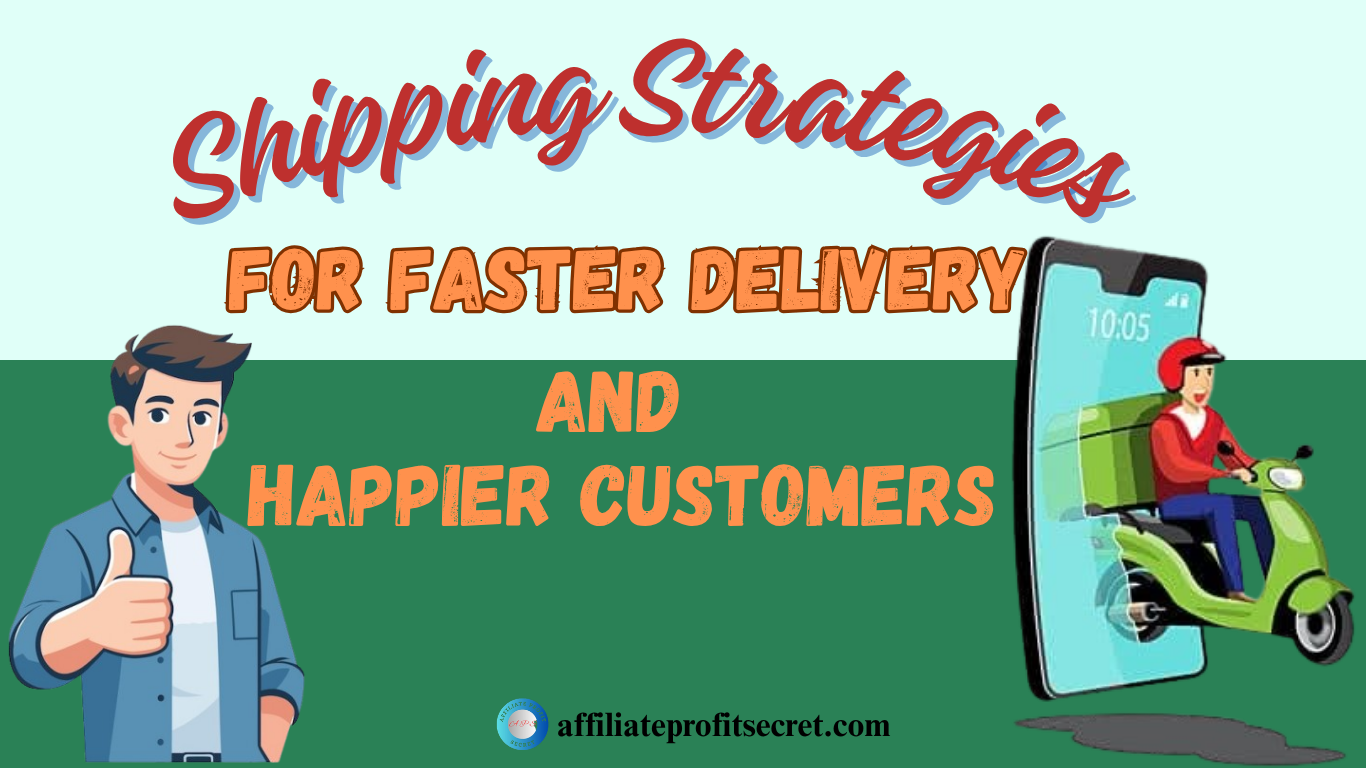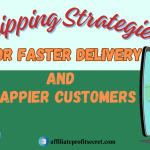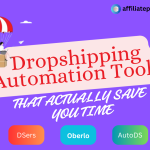Welcome to my article on “Shipping Strategies for Faster Delivery and Happier Customers”.If you run an eCommerce store and think shipping is just about slapping a label on a box and praying it gets there—think again. In 2025, fast, reliable delivery isn’t a bonus; it’s the bare minimum. Thanks to Amazon Prime, customers now expect their order to show up yesterday, complete with tracking, updates, and maybe even a thank-you note from your dog. (Okay, maybe not that last one—but hey, never hurts.) Shipping has become one of the most powerful levers for customer satisfaction—and your bottom line. Mess it up, and you’ll find your store collecting more one-star reviews than orders. Nail it, and you’ll earn repeat customers, glowing feedback, and even the kind of brand loyalty usually reserved for grandma’s cookies.
But here’s the good news: You don’t need a billion-dollar logistics empire to speed up delivery and delight your customers. With the right strategies—think smarter fulfillment models, distributed warehousing, and tools that automate the boring stuff—you can level up your shipping game without losing sleep (or profit margins). In this guide, we’ll walk you through the most effective shipping strategies to cut delivery time, keep your customers smiling, and make your business run smoother than a same-day delivery van. Let’s dive in—and make “Sorry for the delay” a phrase of the past.
My Best Recommended & Proven Way to Make $100-$300 Daily – Watch This FREE Video to START >>>

Choose the Right Fulfillment Model for Your Business
Before you worry about shipping zones, delivery speeds, or fancy packaging tape, let’s address the elephant in the (warehouse): Who’s actually shipping your stuff?
Your fulfillment model is the backbone of your shipping strategy. Pick the right one, and your orders flow out the door like clockwork. Pick the wrong one, and you’ll be buried in boxes, chasing tracking numbers while customers wonder if their order took a detour through Narnia.
Let’s break down the main players:
🏠 In-House Fulfillment (a.k.a. The DIY Method)
You store, pack, and ship every order yourself. This gives you total control, which is great—until your garage looks like a stockroom and your social life disappears. Best for: early-stage stores with low order volume and a high tolerance for packing peanuts.
📦 Third-Party Logistics (3PL) Providers
Outsource the heavy lifting to the pros. A 3PL stores your inventory and handles the pick-pack-ship dance on your behalf. It’s like hiring a fulfillment ninja team—without the payroll headaches. Most 3PLs even integrate with your eCommerce platform to automate the whole process. Best for: growing stores that want scalability without sacrificing speed.
🌍 Dropshipping
You never touch the product. The supplier ships directly to your customer. Simple? Yes. Fast? Not always. You’ll want to choose suppliers with fast processing times and U.S./EU warehouses if possible. Best for: low-risk businesses or those testing new products—but not ideal for Prime-level delivery speeds.
🧠 Hybrid Models
Why choose just one? Some businesses use a combo of in-house + 3PL or dropshipping + warehousing to stay flexible. It’s like fulfillment à la carte. Best for: businesses juggling multiple product lines or markets.
Bottom line? Your fulfillment model should match your growth goals, your budget—and your tolerance for cardboard cuts.
Leverage Distributed Warehousing to Cut Delivery Time
If you’re shipping all your orders from one location—say, your cozy little HQ in New Jersey—every West Coast order is basically a cross-country road trip away. Fun for a summer vacation, not so fun when customers are checking their tracking updates like it’s a Netflix series.
Enter: distributed warehousing. It sounds like a fancy logistics buzzword (and it is), but the concept is simple—store your inventory in multiple fulfillment centers closer to where your customers actually live. That way, your packages don’t need to earn frequent flyer miles to reach their destination on time.
My Best Recommended & Proven Way to Make $100-$300 Daily – Watch This FREE Video to START >>>
Here’s how it works: Let’s say you use a 3PL like ShipBob, Deliverr, or Amazon Multi-Channel Fulfillment. These services offer a network of warehouses across the country (or even internationally). When someone places an order, it ships from the location nearest to them. Boom—faster delivery, lower shipping costs, and a happy customer who didn’t have to wait a week for their yoga pants.
Benefits of Distributed Warehousing:
- Faster shipping: 1–2 day delivery becomes realistic—even without your own fleet of trucks.
- Lower costs: Less distance = less money spent on shipping labels.
- Better customer experience: Fast delivery + accurate tracking = five-star reviews and repeat business.
- Scalability: You can grow into new regions without building a warehouse empire.
Of course, this does require a bit more inventory management. You’ll need to track stock across multiple locations and plan replenishments smartly. But with modern inventory software, it’s more “click-click” than “spreadsheet panic attack.”
In short, distributed warehousing turns your shipping from a slow crawl into a well-oiled, cross-country sprint. And your customers? They’ll barely have time to blink before their package hits the doorstep.
Offer Multiple Shipping Options (Without Overwhelming Customers)
Ever go to checkout and get hit with five shipping choices, each with cryptic names like “Standard Ground Saver Plus™” or “Expedited Unicorn Express”? Yeah—nobody loves a shipping riddle.
Offering multiple shipping options is smart. It gives customers control over their delivery experience—whether they want it fast, cheap, or somewhere in between. But the trick is to offer variety without causing decision fatigue that leads to cart abandonment (a.k.a. the digital walk of shame).
🛍️ Here’s how to get it right:
1. Cover the Three Core Needs: Speed, Cost, and Certainty
- Fast (e.g., 2-day or same-day) – For the “I need this now” shopper. Great for high-intent purchases and last-minute gifts.
- Economy (e.g., 5–8 days) – Perfect for budget-conscious buyers who don’t mind waiting a bit.
- Free Shipping Threshold – Encourage larger orders by offering free standard shipping above a certain cart value. Everyone loves a good deal—even if they add an extra $9.99 just to avoid a $5 shipping fee.
2. Show Estimated Delivery Dates, Not Just Vague Timeframes
“Standard shipping (3–7 business days)” sounds like a shrug. “Arrives by Tuesday, July 9” sounds like you’ve got your life (and logistics) together.
3. Use Real-Time Shipping Calculators
Tools like Shopify Shipping, ShipStation, and Easyship let you show dynamic rates based on order weight, location, and carrier. This keeps your margins safe and builds trust.
4. Be Transparent
No one likes surprise fees or mysterious delivery windows. Spell out what each option actually means in plain language. Bonus points if you give it a friendly tone—”Budget Shipping (5–8 days, ideal for non-urgent orders)” sounds way less stressful than “Standard Ground.”
In short, offer choices—but not chaos. Think of your shipping menu like a restaurant: a few solid options beat a 12-page novel. Keep it clear, keep it simple, and your customers will thank you (likely with their wallets).
Optimize Order Processing & Communication
Fast shipping starts before the package hits the road. If your order processing is slower than a dial-up modem, even the fanciest 2-day shipping won’t save you. That’s why streamlining your order handling—and keeping customers in the loop while you do it—is a game-changer for speed and satisfaction.
Let’s break it down.
⚙️ Step 1: Automate the Boring Stuff
Manual processing is fine when you’ve got five orders a week. But when you’re scaling (or dreaming of scaling), it’s a bottleneck waiting to happen. Use automation tools like Shopify Flow, Zapier, or Order Desk to:
- Auto-send order confirmations
- Automatically tag high-priority or VIP orders
- Push orders to fulfillment services or warehouse teams instantly
Think of it like a digital assembly line—except without the oil stains and loud machinery.
My Best Recommended & Proven Way to Make $100-$300 Daily – Watch This FREE Video to START >>>
🧾 Step 2: Tighten Your Picking, Packing, and Handoff Game
Whether you’re shipping in-house or using a 3PL, every minute matters. Use batch processing to group orders by shipping type, location, or SKU. Invest in barcode scanners to reduce errors (nobody wants a dog toy when they ordered headphones).
Got staff? Train them on speed and accuracy. Got just you? Set up a streamlined workflow so you’re not running around like a caffeinated squirrel looking for packing tape.
📦 Step 3: Communicate Like a Pro
Once the order’s in motion, don’t leave customers hanging in the void. A solid post-purchase communication flow should include:
- Order confirmation email (instant and detailed)
- Shipping notification with tracking link
- Delivery confirmation (bonus points for asking for a review)
- Branded tracking pages (AfterShip and Route make this easy and pretty)
Customers love updates. Even if it’s just “Your order is being prepared,” it reassures them that things are moving—and that you haven’t disappeared into the eCommerce abyss.
The faster and smoother your backend runs, the faster your front end impresses. Optimize the steps behind the scenes, and your shipping strategy becomes less of a stress fest and more of a customer delight machine.
Conclusion: Fast Shipping Isn’t Optional—It’s a Competitive Advantage
Let’s be real—fast shipping is no longer a “nice to have.” It’s table stakes. In the age of Amazon Prime and same-day delivery, customers expect their orders to arrive faster than they can say “add to cart.” And if your store can’t deliver (literally), there’s a good chance they’ll take their business to someone who can.
But here’s the good news: you don’t need billion-dollar logistics to compete. By choosing the right fulfillment model, distributing your inventory smartly, offering clear shipping options, and streamlining your order process like a well-oiled machine, you can punch above your weight—and win customer hearts (and wallets) in the process.
Shipping isn’t just about logistics anymore. It’s part of your brand experience. It’s how you build trust, drive repeat purchases, and earn those sweet five-star reviews. A smooth delivery says, “We’ve got our act together.” A delayed one says, “We’re still figuring this out—please don’t be mad.”
My Best Recommended & Proven Way to Make $100-$300 Daily – Watch This FREE Video to START >>>
So take a look at your current setup. Where can you shave off a day? What can be automated? Is it time to finally let go of that all-in-one shipping label spreadsheet you’ve been nurturing like a pet?
Fast, reliable shipping is one of the best investments you can make in your eCommerce business. It keeps customers happy, reduces support headaches, and turns first-time buyers into loyal fans. Because at the end of the day, people don’t just remember what they ordered—they remember how they received it.
Thanks a lot for reading my article on “Shipping Strategies for Faster Delivery and Happier Customers″ till the end. Hope you’ve helped. See you with another article.










